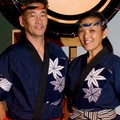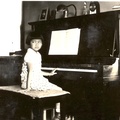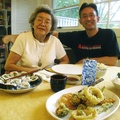Karin Higa, JANM Senior Curator of Art from 1992 to 2006 and consultant on later projects, died October 29, 2013, following a battle with cancer. She was a native of Los Angeles who spent most of her career in Southern California, with a bachelor’s degree from Columbia University in New York and a master’s degree in art history from UCLA. At the time of her death, she was pursuing a Ph.D. in art history at USC. She was 47 years old.
The following brief remembrance is from Sojin Kim, a former JANM curator who worked with Higa from 1998 to 2008.
Karin Higa (1966-2013) was a smart, visionary curator. As director of the JANM exhibitions and curatorial department, she was also generous, principled, and practical.
We, her curatorial staff, knew that she was not a pet person. We were an office of pet-silly people—owners of horses that needed grooming, elderly cats that required special medications, and dogs that wore clothing. Once someone found a litter of week-old abandoned kittens. These were fostered on the loading dock outside the production office, and several times a day we would line up to hold and feed them. Karin was clear about how she perceived our odd, doting regard for animals. We were hypocrites—we were hypocrites because not one of us was a vegetarian—we were okay eating animals—at the same time that we were deeply invested in their sentience.
Pet regard was only one of many lines of difference that distinguished the curatorial staff from one another—generation, disciplinary background, temperament, sense of humor, aesthetic sensibility, communication style were others. Karin was our director—and she shaped from our disparate group a highly productive, creative, and collaborative unit. Karin’s curatorial leadership provided a rigorous environment of learning, stretching, sharing. Dr. Arthur Hansen has described the time during which he was on staff at JANM in our department as being so intellectually dynamic—with ideas flying fast and frequent in our exhibit planning and collection review meetings—that sometimes when he walked into our office he was so overwhelmed with happiness that it brought tears to his eyes.
Among our department’s responsibilities was the determination of which materials were appropriate for the Museum’s permanent collection. Dozens of objects were offered to JANM for consideration each month—and we would divvy up a stack of these “offers,” and prepare “justifications” that argued why we should or should not accept them. Karin cultivated among us a zeal for preparing very deep and detailed reports—carefully researching the historical background and following up with donors to record additional personal recollections. I can still hear her on the phone with an elderly, hard-of-hearing collections donor, enunciating slowly and bellowing her questions so loudly we could hear her from the other room.
The recent JANM exhibition Visible & Invisible: A Hapa Japanese American History featured items from the collection of Walter W. Matsuura, much of which documented the experiences of his mother, née Melba Yonemura. I remember when Karin met with the donor and her review of this collection. She wrote a thorough report detailing a “cast” of seven primary characters (including an Issei father, German American mother, and German mother-in-law), and over pages and pages of single-spaced text, she exuberantly chronicled an epic family history, complete with key dates, quotes from her conversation with the donor, and her conclusion, “…this is a remarkable collection that raises so many questions about the complexity of Japanese American life: the role of World’s Fairs in Japanese migration and cultural expression; interracial marriage and children; unconventional familial situations; the close connection between Japan and the United States (as expressed through baseball); Japanese American presentation in hyper-American contexts (the Rose Parade); Japanese American social life in pre- and post-war period; MIS; relationship between Japanese on the mainland and Hawai‘i, and the list goes on…”
Karin loved the revelations that came from interactions with collection donors as well as JANM volunteers, for whom she had great fondness and respect. She knew the value of the personal story—that in these one found profound insights and historical data. She worked tirelessly to ensure the recognition and legacy of Japanese American artists—insisting that they be considered not in the margins but as part of mainstream art history discourse. She held us to high standards of critical thinking. And along the way, with her, and through her able leadership, all of us in the curatorial and exhibitions department were transformed by the privilege of collaborating with JANM colleagues, volunteers, members, and the public on the ongoing project of shaping an historical record that accounts for the gripping complexity of American history and culture.
© 2014 Sojin Kim / Japanese American National Museum






